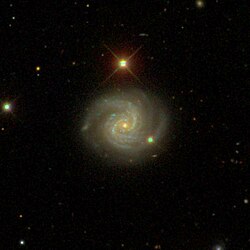
Messier 63 or M63, also known as NGC 5055 or the seldom-used Sunflower Galaxy, is a spiral galaxy in the northern constellation of Canes Venatici with approximately 400 billion stars. M63 was first discovered by the French astronomer Pierre Méchain, then later verified by his colleague Charles Messier on 14 June 1779. The galaxy became listed as object 63 in the Messier Catalogue. In the mid-19th century, Anglo-Irish astronomer Lord Rosse identified spiral structures within the galaxy, making this one of the first galaxies in which such structure was identified.

NGC 7793 is a flocculent spiral galaxy in the southern constellation of Sculptor. It was discovered in 1826 by Scottish astronomer James Dunlop. The galaxy is located at a distance of 12.2 million light years and is receding with a heliocentric radial velocity of 227 km/s. NGC 7793 is one of the five brightest galaxies within the Sculptor Group.
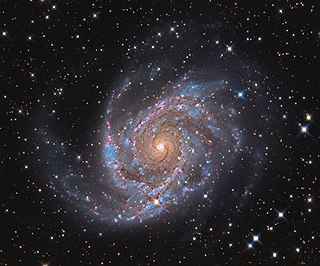
NGC 2997 is a face-on unbarred spiral galaxy about 40 million light-years away in the faint southern constellation of Antlia. It was discovered March 4, 1793 by German-born astronomer William Herschel. J. L. E. Dreyer described it as, "a remarkable object, very faint, very large, very gradually then very suddenly bright middle and 4 arcsec nucleus. This is the brightest galaxy of the NGC 2997 group of galaxies, and was featured on the cover of the first edition of Galactic Dynamics by James Binney and Scott Tremaine.

NGC 5371 is a face-on spiral galaxy in the northern constellation Canes Venatici. It was discovered on January 14, 1788 by German-British astronomer William Herschel. The nearby NGC 5390 appears to be a duplicate entry for NGC 5371, since there is nothing at the former's position. NGC 5371 has an apparent magnitude of 11.3 and an angular size of 4.4′ × 3.5′. It is located at a distance of 129.5 ± 32.4 million light-years (39.70 ± 9.92 Mpc) from the Milky Way, and is receding with a heliocentric radial velocity of 2,552 km/s. The galaxy appears to be weakly interacting with the nearby, equidistant Hickson 68 group of galaxies, and thus may be a member. Collectively, they are sometimes dubbed the Big Lick galaxy group, after the city of Roanoke, Virginia.

NGC 5962 is a spiral galaxy in the equatorial constellation of Serpens Caput. It was discovered by the Anglo-German astronomer William Herschel on March 21, 1784. The NGC 5962 galaxy is located at a distance of 120 million light years and is receding with a heliocentric radial velocity of 1,957 km/s. It is the brightest member of the eponymously-named NGC 5962 group, which overlaps with the nearby NGC 5970 group; the two groups may be gravitationally bound.

NGC 6340 is an unbarred spiral galaxy in the northern constellation of Draco. It was discovered by German-British astronomer William Herschel on June 6, 1788. The galaxy is located approximately 55 million light-years (17 Mpc) away, and is receding with a heliocentric radial velocity of 1,217 km/s. It is the largest member of a triplet of galaxies known as the NGC 6340 group.
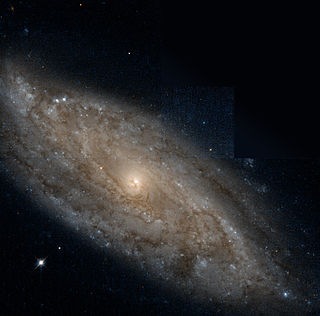
NGC 7314 is a spiral galaxy located in the southern constellation of Piscis Austrinus. It was discovered by English astronomer John Herschel on July 29, 1834. This is a nearby Seyfert (active) galaxy, located at a distance of approximately 54.6 megalight-years from the Milky Way. Since it appears to have detached spiral arm segments, it was listed in Halton Arp's Atlas of Peculiar Galaxies.

NGC 27 is a spiral galaxy located in the constellation Andromeda. It was discovered on 3 August 1884 by Lewis Swift. It forms a galaxy pair with the nearby UGC 95.

NGC 6503 is a field dwarf spiral galaxy in the northern constellation of Draco. It was discovered by German astronomer Arthur von Auwers on July 22, 1854. The galaxy has an angular size of 7.1′ × 2.4′ and an apparent visual magnitude of 10.2. It is located at a distance of approximately 20.9 million light-years (6.40 Mpc) from the Milky Way galaxy. NGC 6503 may form the remote tip of a long chain of galaxies that extends out into the local void, forming a galaxy filament spanning 26 million light-years (8 Mpc).
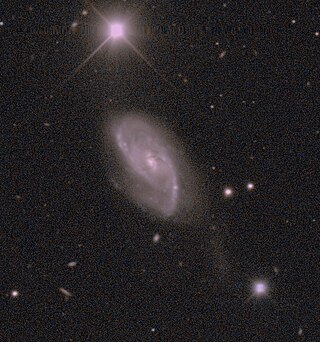
NGC 66 is a barred spiral galaxy discovered by Frank Muller in 1886, and is located in the Cetus constellation.
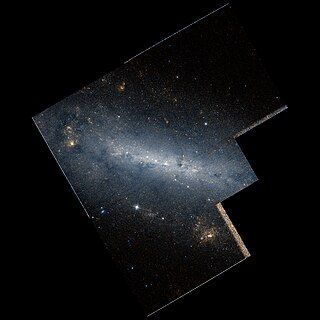
NGC 672 is a spiral galaxy in the northern constellation of Triangulum, positioned around 2° to the southwest of the star Alpha Trianguli. The original object designated NGC 672 was discovered by the German-born astronomer William Herschel on 26 October 1786, but this was later cataloged as NGC 614. The object now identified as NGC 672 was discovered by John Herschel on 11 November 1827.

NGC 4424 is a spiral galaxy located in the equatorial constellation of Virgo. It was discovered February 27, 1865 by German astronomer Heinrich Louis d'Arrest. This galaxy is located at a distance of 13.5 million light years and is receding with a heliocentric radial velocity of 442 km/s. It has a morphological class of SB(s)a, which normally indicates a spiral galaxy with a barred structure (SB), no inner ring feature (s), and tightly-wound spiral arms (a). The galactic plane is inclined at an angle of 62° to the line of sight from the Earth. It is a likely member of the Virgo Cluster of galaxies.

NGC 5917 is a spiral galaxy located in the constellation of Libra. It was discovered by English astronomer John Herschel on 16 July 1835. This galaxy is located at a distance of 90.4 ± 6.2 million light-years (27.73 ± 1.90 Mpc) from the Milky Way, and is receding with a heliocentric radial velocity of 1,934.1 km/s. It is interacting with the neighboring galaxy, PGC 54817, at an angular separation of 4.2′. Tidal tails extend from PGC 54817 to the halo of NGC 5917.

NGC 6902 is an unbarred spiral galaxy located in the southern constellation of Sagittarius at an approximate distance of 124 million light-years (38.0 Mpc). NGC 6902 was discovered on September 2, 1836 by English astronomer John Herschel. In his New General Catalogue, Danish astronomer J. L. E. Dreyer described it as faint, considerably small, round, brighter middle. It is a member of the small NGC 6092 group of galaxies; the LGG 434 group.

NGC 4800 is an isolated spiral galaxy in the constellation Canes Venatici, located at a distance of 95 megalight-years from the Milky Way. It was discovered by William Herschel on April 1, 1788. The morphological classification of this galaxy is SA(rs)b, indicating a spiral galaxy with no visual bar at the nucleus (SA), an incomplete ring structure (rs), and moderately-tightly wound spiral arms (b). The galactic plane is inclined to the line of sight by an angle of 43°, and the long axis is oriented along a position angle of 25°. There is a weak bar structure at the nucleus that is visible in the infrared.

NGC 3294 is a spiral galaxy in the constellation Leo Minor. It was discovered by William Herschel on Mar 17, 1787. It is a member of the Leo II Groups, a series of galaxies and galaxy clusters strung out from the right edge of the Virgo Supercluster. The galaxy is located at a distance of 98 million light years and is receding with a heliocentric radial velocity of 1,586 km/s. The morphological class of NGC 3294 is SA(rs)bc, which means this is a spiral galaxy with no central bar (SA), an incomplete inner ring structure (rs), and moderately wound spiral arms (bc).

NGC 1325 is a flocculent spiral galaxy situated in the constellation of Eridanus. Located about 75 million light years away, it is a member of the Eridanus cluster of galaxies, a cluster of about 200 galaxies. It was discovered by William Herschel on 19 December 1799.

NGC 6509 is a spiral galaxy in the equatorial constellation of Ophiuchus. It was discovered on July 20, 1879 by the French astronomer Édouard Stephan. This galaxy is located at a distance of 95.3 million light-years (29.22 Mpc) from the Milky Way, and is receding with a heliocentric radial velocity of 1,814 km/s.
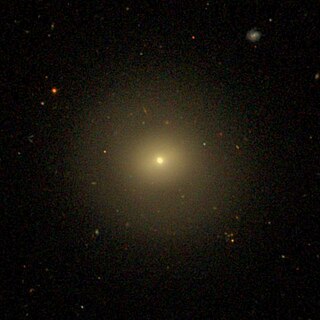
NGC 3599 is a lenticular galaxy located in the constellation Leo. It was discovered by William Herschel on March 14, 1784. The galaxy is located at a distance of 67 million light-years (20.4 Mpc) from the Sun. NGC 3599 is a member of the Leo II group of galaxies in the Virgocentric flow.

NGC 5273 is a lenticular galaxy located 54 million light-years away in the northern constellation of Canes Venatici. This galaxy was discovered by William Herschel on May 1, 1785. It is positioned 1+1⁄4° to the southeast of the star 25 Canum Venaticorum.
